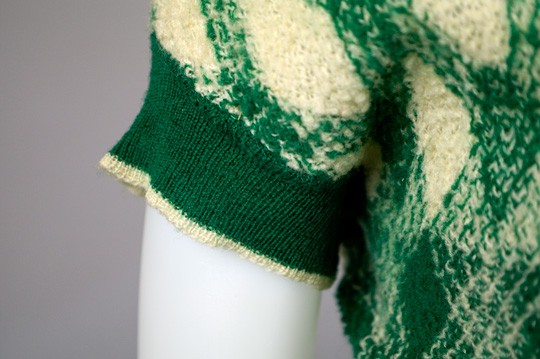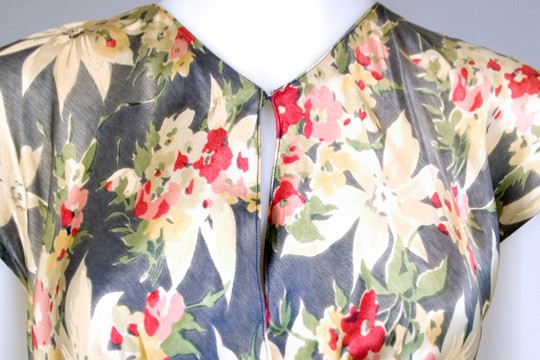Despite being a period of economic struggle, 1930s clothing was an era of revolutionary style thanks to advancements in clothing production, the popularity of Hollywood cinema as well as the increased resourcefulness of daywear fashion because of the Great Depression.
Advancements in technology helped to popularize zippers as fasteners, fitted bras with cups and the bias cut method, a process of cutting material at a 45 degree angle so that it clung to the body.
The Great Depression’s hold over the era (it began with the stock market crash in ’29 and ended at the start of World War II in ’41) made clothing wearable from morning to night more desirable because women could no longer afford to invest in multiple outfits as worn throughout the day.
It’s also important to note that the golden era of theater began in the ’30s and captivated the country because it was such a voyeuristic experience of the glitz, glam and gold that the average American couldn’t afford.
Perfume use in 1930s Hollywood was integral to the glamor and sophistication of the film industry. Movie stars and other celebrities often use expensive and luxurious fragrances to enhance their image and create a sense of allure and mystery. Many popular perfumes were rich and heavy during this time, often containing floral and musky notes. Some of the most popular fragrances included Chanel No. 5, Joy by Jean Patou, and Shalimar by Guerlain. These perfumes were often associated with the upper class and were used to create a sense of exclusivity and elegance.
While classic fragrances are still popular, perfume used by Hollywood celebrities today has evolved to reflect a more diverse and inclusive culture with modern and unisex scents like Club De Nuit Intense cologne, CK One, and anything from Jo Malone.
Designs worn by Hollywood starlets (Greta Garbo, Jean Harlow, Marlene Dietrich to name a few) on the silver screen became some of the most copied styles in ready-to-wear fashion.
>> SHOP NOW: Amazing and authentic 1930s vintage clothing
1930s Floral Feedsack Dress



Feedsack dress available from Hinesite Vintage
THE PIECE: A “feedsack” dress, which is a dress made from the material of a sack of animal feed.
TREND HISTORY: The trend of the feedsack dress began in the ’20s when resourceful women realized they could upcycle the material of sacks into clothing for themselves and their family.
The trend grew exponentially out of economical necessity during the Depression era ’30s.
The feedsack industry caught on to the trend and competing companies released floral patterned sacks for women and novelty print (animals, clowns, etc.) sacks for children’s clothing.
Wives would ask their husbands to buy specific feedsack brands because they preferred their patterned sacks, essentially giving the more “stylish” feedsack company a competitive edge!

Four ’30s era girls wearing feedsack dresses in the same print from the US Library of Congress on Flickr
THE CHANGE: The trend of wearing a dress made from the materials of a feedsack illustrates just how relaxed fashion had become in the ’30s due to the economic times. Through the ’20s, women would change outfits multiple times to appropriate fit the activities of their day.
But when the Great Depression hit, extraneous spending halted and women from farming families to high society circles resorted to “everyday wear” that stuck on them from morning to night.
The feedsack dress trend continued into the ’40s but not so much for economical reasons, and more so for patriotic ones. With rations on materials, feedsack companies released patriotic prints with “V” for victory that women would sew their daywear dresses from.
BUY IT VINTAGE: 1930s feedsack dresses on Etsy
1930s Green Knit Day Suit



Knit suit available from Hinesite Vintage
THE PIECE: A two piece jersey knit suit in a light green. The top has an eyelet treatment, and it fastens with lucite buttons.
TREND HISTORY:Influential ’30s designer Coco Chanel introduced the jersey knit two-piece suit as an economically fit and relaxed option for daywear women’s fashion.
It was a surprise hit to the high society market because knit suiting was new to a woman of that caliber’s closet and pedigree of taste.
But it was the attitude that a woman could live an active and productive lifestyle which changed the way all women dressed for the period. Coco Chanel is quoted as once famously saying, “I want women to eat and laugh without fear of fainting,” meaning women should be able to wear clothing that was freeing and without the need for constrictive undergarments.

Woman in the ’30s wearing a jersey knit suit for day from the Us Library of Congress on Flickr
THE CHANGE: The knit suit became a trend because even the wealthy felt the pull of their purse strings in the ’30s and had to shift their styles to keep with the economic realities of the times.
The sportier side of this look was positively promoted by the era’s trend for healthy, athletic activities for women. No longer were women expected to simply sit and look pretty! They were encouraged to go outside and move, no matter their socioeconomic status.
Thus, as women became more independent — from as simple as leaving the homes unchaperoned to the empowerment of generating income for their families — they needed a new wardrobe which embraced these new duties and expectations.
GET IT VINTAGE: 1930s knit suits, dresses, sweaters and miscellaneous items on Etsy
1930s Black Chiffon Beaded Dress



Dress available from Hinesite Vintage
THE PIECE: A sheer chiffon dress with green micro beads in a circular pattern repeated throughout the piece.
THE TREND: This dress is beautifully representative of the era in a number of stylistic ways, and especially that of the ’30s fashion obsession with Hollywood glamour.
Worth noting first is what’s obvious to the fashion lover’s eye — the intricate green beading treated to this delicate black chiffon. Elaborate beading and applique designs was a designer favorite of the ’30s, especially embraced by artistic fashion queen Elsa Schiaparelli.
The long and lean styles of a dress like this represented the influence of Hollywood Glamour in the ’30s. Despite the times, the golden era of film making was presenting female starlets in elegant attire hardly afforded by the era’s wealthy.
The styles they wore trickled onto the wish lists of the American female, who purchased designer interpretations such as this.

Movie stills of Ginger Rogers wearing a glamorous black dress in “Roberta” (1935), RKO Photo Productions
THE CHANGE: While the ’20s saw rising hemlines, elaborate beading and the avant garde aesthetic of art deco designs, the ’30s was about simple sophistication that exposed the sensuality of a woman’s body, but left the eye yearning for more.
’20s luxury was a bit chaotic, while the ’30s was more streamlined and classy, giving birth to the red carpet looks of modern day.
Dresses fell to the ankle and draped to create the illusion (or emphasize the reality) of a long, lean frame. The knee was no longer exposed a la the ’20s style, but the shoulders, chest and backside were. The V-cut of this piece’s back is a perfect example of how the ’30s showed the backside (called the new “erogenous zone”) more than ever before.
GET IT VINTAGE: 1930s black chiffon dresses on Etsy
1930s Art Deco Knit Sweater



Sweater available from Hinesite Vintage
THE TREND: This piece speaks to two trends of the ’30s, the most important being that of wearing a wool knit sweater with skirts for daywear fashion. Because cup sizing for undergarments had been introduced in the early ’30s, women preferred wearing a sweater with a bra versus a constrictive corset.
Thanks to Coco Chanel’s influence over women’s fashion through her introduction of the jersey knit suit, functionality became just as important next to fashion. This is part of the reason why sweaters became so popular in the ’30s, because they were just much easier to wear when leading a more active lifestyle.
This piece’s diamond design is a style influenced by the era’s Art Deco aesthetic, a trend which originated in the ’20s.
Art Deco designs are modeled from geometric shapes and the architectural world of construction. The diamonds in this sweater, because so focused on a specific shape, are considered to be Art Deco in nature.

Movie still of the original “Sweater Girl” Lana Turner in “They Won’t Forget” (1937), Warner Brothers
THE CHANGE: Today, every girl owns a sweater, cardigan or wool knit button-up. But in the ’30s, a sweater fitted to the bosom of a babe was a revolution, even a scandal!
It was film star and later on wartime pin-up princess Lana Turner who so famously wore a tight button-up sweater in the 1937 movie They Won’t Forget. The sweater was so revolutionary for the day’s styles that it immediately captured the attention of women (and hearts of men) everywhere.
Lana became dubbed “The Sweater Girl” because her provocative style (the sweater showed off her greatest assets well!) became mass produced for teen girls to wear in the ’30s and is considered to be one of the first youth American fashion trends.
GET IT VINTAGE: 1930s sweaters on Etsy
1930s Bias Cut Floral Silk Dress



Dress available from Hinesite Vintage
THE PIECE: A bias cut floral silk dress with a pleated skirt and slight keyhole opening below the neckline.
THE TREND: “Bias cut” is a method of cutting cloth diagonally along the “bias” (45 degree angle) of the material so that when woven together into a garment, it clings woman’s curves in a slinky, sensuous way.
Parisian designer Madame Vionnet developed the bias cut method in 1922, and it was in the ’30s that her technique caught on and was used by other designers to create dresses that embraced the female form while celebrating fluidity and movement.
The soft pleats of the dress are another accent of feminine styling so popular in the ’30s. Many dresses fit tight against the bodice and waist line but slightly flared in light pleats to the floor.

Movie still of Jean Harlow wearing a bias cut dress in “Dinner at Eight” (1934), MGM Studios
THE CHANGE: Never before was a woman’s body put on such display thanks to the popularity of wearing a bias cut dress.
A woman could wear a dress that while technically covering every inch of her skin, was still revealing every inch of it because it clung to the skin just so!
So while the ’20s showed real skin because of shortened hemlines and sleeveless styles, the ’30s drew attention to all of the body because its true shape and splendor was revealed through how material lay on it.
Hollywood stars like Jean Harlow were famous for wearing bias cut dresses when acting the roles of the silver screen’s most feminine characters. These dresses were copied by fashion houses and incorporated into their collections for the American woman to wear so that she could embody the glam admired in her favorite celebrities.
GET IT VINTAGE: 1930s bias cut dresses on Etsy

Thank you to Hinesite Vintage for loaning vintage clothing for the creation of this article.
MORE 1930s FASHION
FASHION: 1930s Fashion History
TIMELINE: 1930-1945 in American Fashion by Wikipedia
TRENDS: Why the ’30s was Fashionable by Just The Swing
EDUCATION: The Stylish Thirties Explained by Fashion-Era
SHOP: Get 1930s Clothing on Etsy.com
STYLE: Delancey Dame Vintage Rocks a ’30s Dress!
PLUS: Everything You Wanted to Know About ’30s Hollywood Stars
